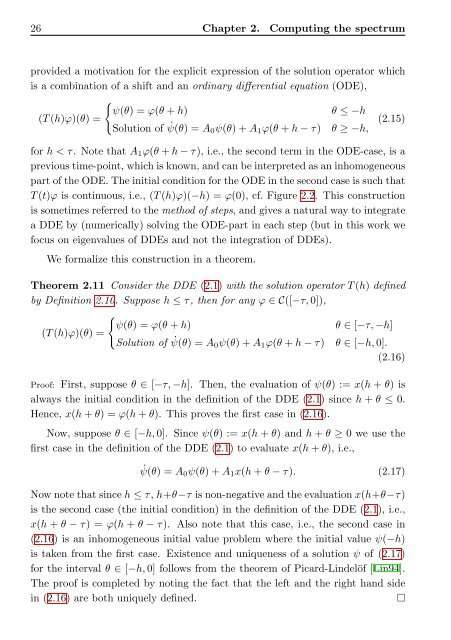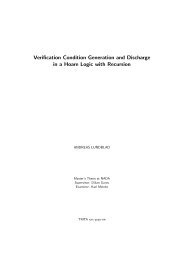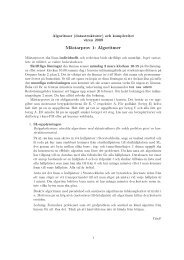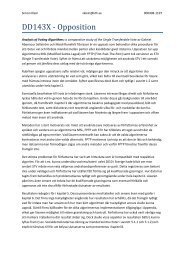The spectrum of delay-differential equations: numerical methods - KTH
The spectrum of delay-differential equations: numerical methods - KTH
The spectrum of delay-differential equations: numerical methods - KTH
You also want an ePaper? Increase the reach of your titles
YUMPU automatically turns print PDFs into web optimized ePapers that Google loves.
26 Chapter 2. Computing the <strong>spectrum</strong><br />
provided a motivation for the explicit expression <strong>of</strong> the solution operator which<br />
is a combination <strong>of</strong> a shift and an ordinary <strong>differential</strong> equation (ODE),<br />
�<br />
ψ(θ) = ϕ(θ + h) θ ≤ −h<br />
(T (h)ϕ)(θ) =<br />
(2.15)<br />
Solution <strong>of</strong> ψ(θ) ˙ = A0ψ(θ) + A1ϕ(θ + h − τ) θ ≥ −h,<br />
for h < τ. Note that A1ϕ(θ + h − τ), i.e., the second term in the ODE-case, is a<br />
previous time-point, which is known, and can be interpreted as an inhomogeneous<br />
part <strong>of</strong> the ODE. <strong>The</strong> initial condition for the ODE in the second case is such that<br />
T (t)ϕ is continuous, i.e., (T (h)ϕ)(−h) = ϕ(0), cf. Figure 2.2. This construction<br />
is sometimes referred to the method <strong>of</strong> steps, and gives a natural way to integrate<br />
a DDE by (<strong>numerical</strong>ly) solving the ODE-part in each step (but in this work we<br />
focus on eigenvalues <strong>of</strong> DDEs and not the integration <strong>of</strong> DDEs).<br />
We formalize this construction in a theorem.<br />
<strong>The</strong>orem 2.11 Consider the DDE (2.1) with the solution operator T (h) defined<br />
by Definition 2.10. Suppose h ≤ τ, then for any ϕ ∈ C([−τ, 0]),<br />
�<br />
ψ(θ) = ϕ(θ + h) θ ∈ [−τ, −h]<br />
(T (h)ϕ)(θ) =<br />
Solution <strong>of</strong> ˙ ψ(θ) = A0ψ(θ) + A1ϕ(θ + h − τ) θ ∈ [−h, 0].<br />
(2.16)<br />
Pro<strong>of</strong>: First, suppose θ ∈ [−τ, −h]. <strong>The</strong>n, the evaluation <strong>of</strong> ψ(θ) := x(h + θ) is<br />
always the initial condition in the definition <strong>of</strong> the DDE (2.1) since h + θ ≤ 0.<br />
Hence, x(h + θ) = ϕ(h + θ). This proves the first case in (2.16).<br />
Now, suppose θ ∈ [−h, 0]. Since ψ(θ) := x(h + θ) and h + θ ≥ 0 we use the<br />
first case in the definition <strong>of</strong> the DDE (2.1) to evaluate x(h + θ), i.e.,<br />
˙ψ(θ) = A0ψ(θ) + A1x(h + θ − τ). (2.17)<br />
Now note that since h ≤ τ, h+θ−τ is non-negative and the evaluation x(h+θ−τ)<br />
is the second case (the initial condition) in the definition <strong>of</strong> the DDE (2.1), i.e.,<br />
x(h + θ − τ) = ϕ(h + θ − τ). Also note that this case, i.e., the second case in<br />
(2.16) is an inhomogeneous initial value problem where the initial value ψ(−h)<br />
is taken from the first case. Existence and uniqueness <strong>of</strong> a solution ψ <strong>of</strong> (2.17)<br />
for the interval θ ∈ [−h, 0] follows from the theorem <strong>of</strong> Picard-Lindelöf [Lin94].<br />
<strong>The</strong> pro<strong>of</strong> is completed by noting the fact that the left and the right hand side<br />
in (2.16) are both uniquely defined. �

















